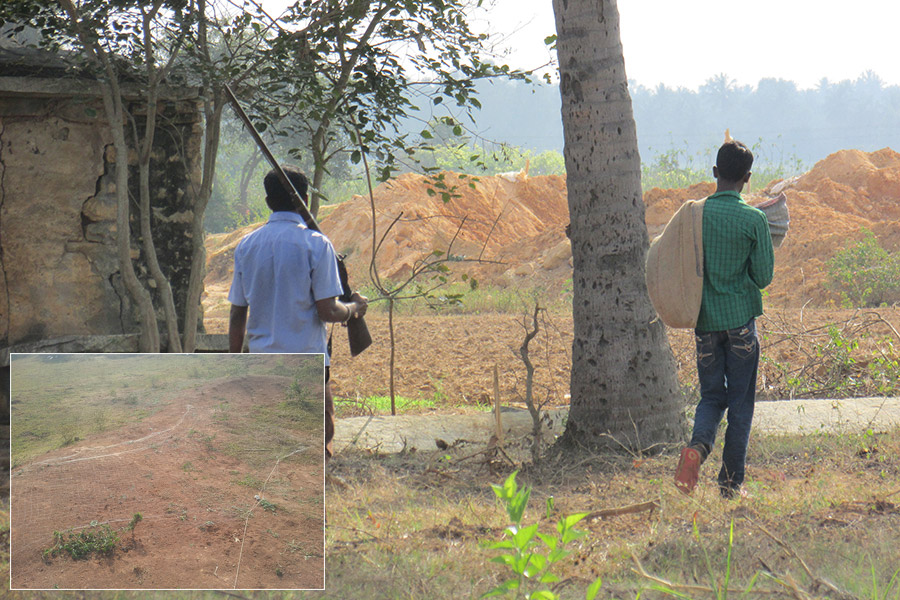 "
"
Bird poaching was one of the pressures that birds in the city faced in the 90’s. It was thought to have died down since then. So much so that, during the planning of the Bangalore Mid Winter Water Bird survey 2015-2016, the coordinators and those assisting in planning the survey had considered dropping some of the parameters such as bird netting, bird shooting, poaching, trapping, etc. However, we were in for a rude shock when we visited a few survey sites, especially in the North West sector of Bangalore. At many sites, we heard gunshots while on the survey. We even came across a couple of poachers who were getting ready to shoot migratory birds. “Shooting birds for fun”, was what they had to say when we enquired as to what they were doing there.
Our first encounter of poaching and bird shooting this year was at Ardeshanhalli, where we could hear distinct gunshots every five to ten minutes. This site was just beside the Yelahanka Air Force Base and the constant shots may have been to drive away or kill birds on the runway. We counted over twenty Black- headed Ibis, a lone Woolly-necked Stork and a large number of Egrets at this site, among other birds. We also came across a bird trapping net which was pinned to the ground, probably to trap partridges and other ground birds. There was also active army training going on outside the compound walls of the air base at the time the survey was conducted, but it didn’t seem like they were doing any firing.
Another site we came across bird shooting was at Gantiganahalli, where gunshots were heard piercing the air as early as 6:00 am. There was no visible sign of bird trapping or shooting, and it was unclear as to which direction the shots were coming from. However, the shots did cause panic among the various ducks and other birds present there. The shots would be fired and the birds would scatter in panic every time.
Similarly, gun shots were heard at Bellandur Lake, from the wind tunnel road side. It is possible the Armed forces were firing at birds to keep them away from the apron where aircraft would come in after flights. Bande Kodigenahalli and Chikka Sanne were also other sites where gunshots were heard. The survey teams did not find any visible traces of netting nor did they see who was firing the shots.
Dodda Tumkur yielded great counts and species diversity among which were Painted Storks, Egrets and a good number of Spoonbills. After taking counts from the bund and then walking round the perimeter of the water spread area, we heard a gunshot. Now, when we had first counted, there were thirty four Painted Storks. However, after the shot was fired and all the birds took to the air in panic, we counted just thirty three. I cannot say with certainty that one bird was shot, but the evidence points towards it. The team could not explore the site to look for a carcass because the terrain was inaccessible. There were also multiple nets left around on the shore, but it is uncertain if these were fishing nets or they belonged to the poachers.
Our first actual sighting of poachers was at Manchapanahalli, where after we were done with our count and were returning, we came across these two poachers, one of whom was carrying a huge muzzle loading gun and another with a bag full of what appeared to be birds, and a few nets. But they way the bag drooped down, it looked there must have been a bird in it from a previous hunt. The individual with the gun had absolutely no inhibition in flaunting it. His demeanor clearly showed that he’s been visiting the site often and knows that there isn’t anyone around to question him. When we did stop them to ask what they were doing with a gun, he said he was there to shoot birds; for fun. His associate, however, didn’t speak much and they walked off without being ever so bothered about our presence even after we clicked a few photos of them.
This is a growing cause for concern as most of the poaching activities happen during peak migration season when birds from Eurasia and across the Himalayas come over to Bangalore to seek some respite from the harsh conditions in their breeding grounds. When birds that have traveled such large distances, covering ten thousand or more kilometers to seek respite, are faced with such pressures, it will only drive them to extinction. Not just that, one must realize that while most long distance migrants do not breed in India, the resident birds still do, and activities like gunshots and poaching can put serious pressures on the survival of both residents and migrants. What happens to abandoned nests? Injured birds and chicks that have been orphaned are left to fend for themselves. How long before we push out all the migrants from what is left of our wetlands and the deplorable state they are already in?
Local waterfowl hunting such as this is rampant across India in both urban and rural areas. If you come across any such incidents please report them immediately to local law enforcement officials.

 CI is a non-profit, non-commercial portal that aims to facilitate wildlife and nature conservation by providing reliable information and the tools needed to campaign effectively.
CI is a non-profit, non-commercial portal that aims to facilitate wildlife and nature conservation by providing reliable information and the tools needed to campaign effectively.
Chosen as 'Picture of the Week'
Waterfowl poaching is a growing cause for concern as most of the poaching activities happen during peak migration season when birds from Eurasia and across the Himalayas come over to Bangalore to seek some respite from the harsh conditions in their breeding grounds.